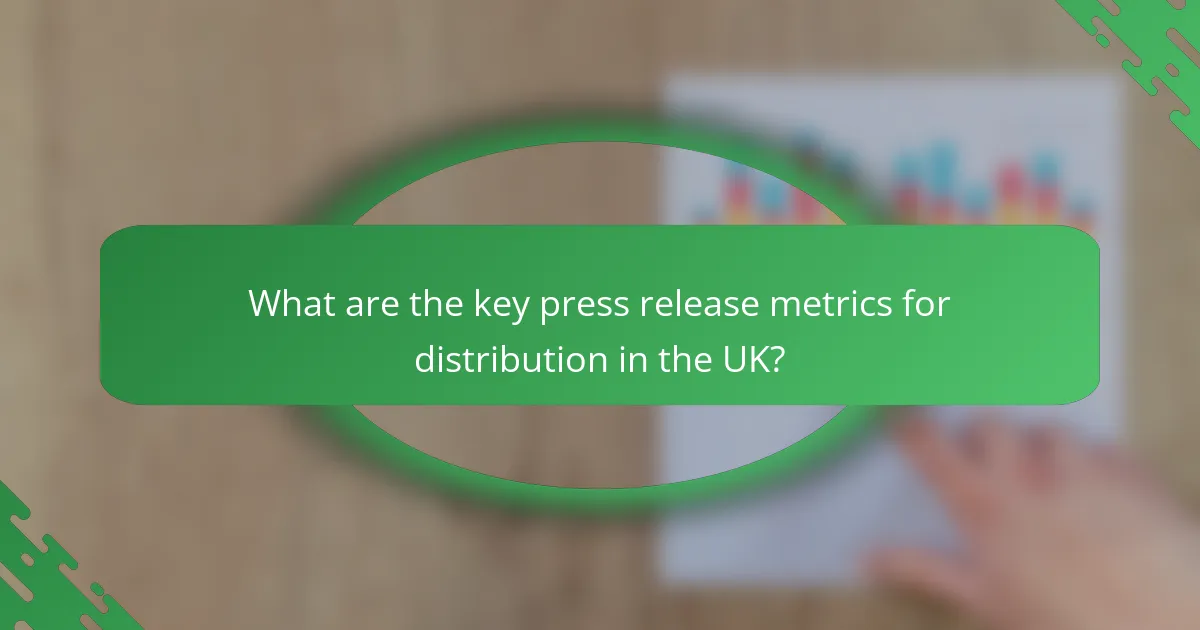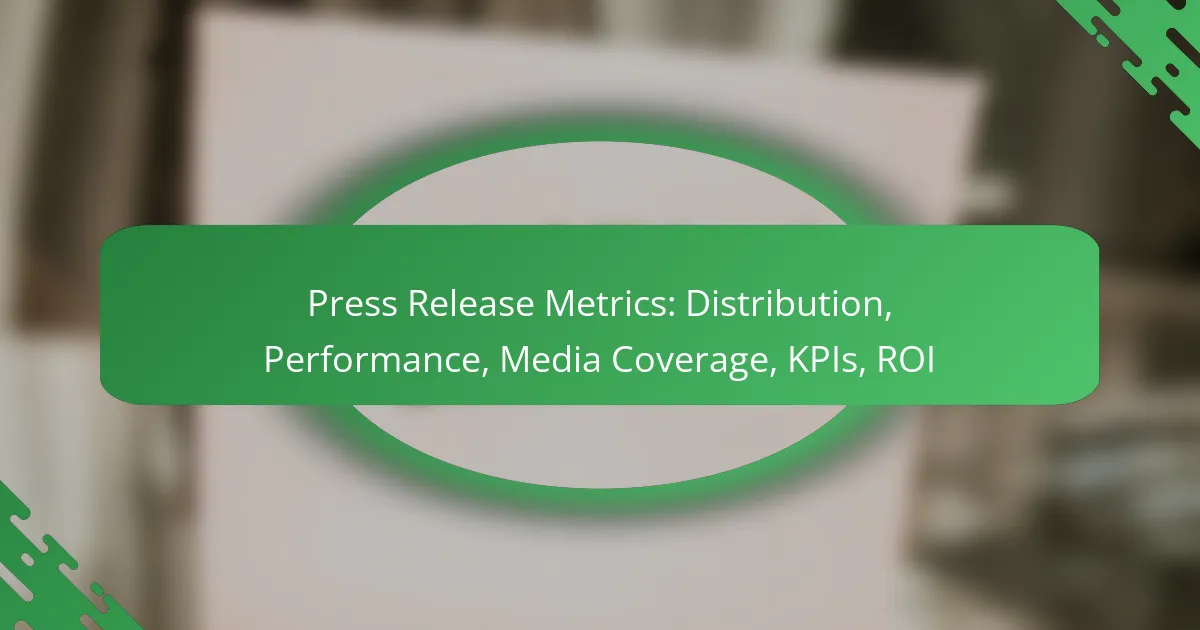Effective press release metrics are crucial for evaluating distribution, performance, and media coverage, enabling businesses to refine their communication strategies. By analyzing key performance indicators such as engagement rates and media mentions, organizations can gain valuable insights into their audience’s response and the overall impact of their press releases. Understanding these metrics not only enhances visibility but also drives conversions and strengthens brand perception.

What are the key press release metrics for distribution in the UK?
The key press release metrics for distribution in the UK focus on assessing how effectively a press release reaches its intended audience and generates engagement. Understanding these metrics helps businesses evaluate the success of their communication strategies and optimize future releases.
Reach and impressions
Reach refers to the total number of unique individuals who see a press release, while impressions indicate how many times it is displayed, regardless of whether it was clicked. In the UK, a successful press release should aim for a reach in the thousands, depending on the target audience and distribution method.
To maximize reach and impressions, consider using a mix of online platforms, social media, and traditional media outlets. Tracking these metrics can provide insights into the effectiveness of different channels.
Target audience engagement
Target audience engagement measures how well the press release resonates with the intended demographic. Metrics such as click-through rates (CTR), shares, and comments are vital indicators of engagement levels. A good CTR for press releases typically ranges from 2% to 5%.
To enhance engagement, tailor the content to address the interests and needs of the audience. Using compelling headlines and clear calls to action can significantly improve interaction rates.
Distribution channels effectiveness
Evaluating the effectiveness of distribution channels involves analyzing which platforms yield the best results in terms of reach and engagement. Common channels include newswire services, social media, and email newsletters.
Consider A/B testing different channels to determine which performs best for your specific audience. Regularly reviewing channel performance can help refine your distribution strategy over time.
Media outlet coverage
Media outlet coverage assesses how many and which media outlets pick up the press release. This metric is crucial for understanding the press release’s visibility in the broader media landscape. Aim for coverage in reputable outlets to enhance credibility.
To increase the likelihood of media coverage, build relationships with journalists and tailor press releases to their interests. Monitoring media mentions can provide valuable feedback on the effectiveness of your outreach efforts.
Geographic reach analysis
Geographic reach analysis focuses on the locations where the press release is most viewed and engaged with. This is particularly important for businesses targeting specific regions within the UK. Understanding geographic performance can inform localized marketing strategies.
Utilize analytics tools to track where your audience is located and adjust your distribution strategy accordingly. Targeting specific regions can lead to more effective communication and higher engagement rates.

How to measure press release performance effectively?
Measuring press release performance involves analyzing various metrics to understand its impact and reach. Key areas of focus include engagement rates, click-through rates, social media shares, and media mentions, which collectively provide insights into the effectiveness of your distribution strategy.
Engagement rates
Engagement rates indicate how well your audience interacts with your press release. This can include metrics such as comments, likes, and shares on platforms where the release is published. A higher engagement rate often signifies that the content resonates with the audience.
To calculate engagement rates, divide the total interactions by the total views or impressions, then multiply by 100 to get a percentage. Aim for engagement rates above 5% to consider your press release effective.
Click-through rates
Click-through rates (CTR) measure the percentage of people who click on a link within your press release compared to the total number of viewers. This metric is crucial for assessing the effectiveness of your call-to-action and overall content appeal.
A good CTR typically ranges from 2% to 5%. To improve your CTR, ensure that links are clearly visible and relevant to the content, and consider using compelling language that encourages clicks.
Social media shares
Social media shares reflect how often your press release is shared across various platforms, indicating its reach and popularity. This metric can amplify your message and increase visibility beyond your immediate audience.
To track social media shares, use analytics tools that monitor engagement on platforms like Facebook, Twitter, and LinkedIn. Aiming for a minimum of 50 shares can be a good benchmark for measuring success, but this can vary based on your industry and audience size.
Media mentions
Media mentions track how often your press release is cited or referenced by journalists and media outlets. This metric is essential for understanding the press release’s impact on media coverage and public relations efforts.
To measure media mentions, utilize media monitoring tools that can provide reports on how frequently your content appears in news articles or blogs. Aiming for at least 5-10 mentions in reputable outlets can indicate a successful press release.

What are the essential KPIs for press releases?
The essential KPIs for press releases include metrics that measure the effectiveness of distribution, audience engagement, and overall impact on brand perception. Key performance indicators help assess how well a press release achieves its goals, such as increasing visibility and driving conversions.
Conversion rates
Conversion rates indicate the percentage of readers who take a desired action after engaging with a press release, such as signing up for a newsletter or making a purchase. Tracking this metric helps determine the effectiveness of the content in prompting readers to act.
To calculate conversion rates, divide the number of conversions by the total number of readers, then multiply by 100. For example, if 1000 people read the release and 50 convert, the conversion rate is 5%. Aim for a conversion rate that aligns with industry benchmarks, which typically range from 1% to 5% for press releases.
Audience growth
Audience growth measures the increase in followers, subscribers, or engagement levels following the release of a press announcement. This KPI reflects the press release’s ability to attract new audiences and expand brand reach.
Monitor audience growth by comparing metrics before and after the release. For instance, if your social media followers increase from 1,000 to 1,200 after a press release, you have achieved a 20% growth. Consistent audience growth is crucial for long-term brand success.
Brand sentiment analysis
Brand sentiment analysis evaluates public perception of your brand following a press release. This KPI assesses whether the coverage is positive, negative, or neutral, providing insight into how the message resonates with the audience.
Utilize tools that analyze social media mentions, comments, and media coverage to gauge sentiment. A positive sentiment score indicates effective communication, while negative feedback may highlight areas for improvement. Regularly monitoring sentiment helps in adjusting future messaging strategies.
ROI calculation
ROI calculation for press releases measures the financial return generated from the investment in creating and distributing the release. This metric helps determine the overall effectiveness and value of press release efforts.
To calculate ROI, subtract the total costs of the press release from the total revenue generated, then divide by the total costs and multiply by 100. For example, if the press release costs $1,000 and generates $5,000 in revenue, the ROI would be 400%. Aim for a positive ROI to justify ongoing investment in press release strategies.

How to analyze media coverage of press releases?
Analyzing media coverage of press releases involves evaluating various metrics to understand their impact and reach. Key areas to focus on include media sentiment, coverage volume, and influencer engagement, which together provide a comprehensive view of how the press release is received.
Media sentiment scoring
Media sentiment scoring assesses the tone of the coverage generated by a press release. This can range from positive to negative, with neutral being a middle ground. Tools like sentiment analysis software can help quantify this sentiment, often using a scale from -1 (negative) to +1 (positive).
When analyzing sentiment, consider the context of the coverage. A generally positive sentiment might still be influenced by a few negative articles, so look for overall trends rather than isolated instances. Regularly tracking sentiment can help identify shifts in public perception over time.
Coverage volume
Coverage volume refers to the number of media outlets that publish articles or mentions related to a press release. A higher volume typically indicates greater interest and reach. To evaluate this, track the number of articles, blog posts, and social media mentions over a specific period.
When assessing coverage volume, consider the quality of the outlets as well. Coverage from reputable sources can carry more weight than numerous mentions from lesser-known blogs. Aim for a balanced approach that values both quantity and quality in your media coverage analysis.
Influencer engagement
Influencer engagement measures how effectively a press release resonates with key industry figures and thought leaders. This can include shares, comments, or direct mentions by influencers on social media platforms. Engaging influencers can amplify the reach and credibility of your message.
To enhance influencer engagement, identify relevant influencers in your industry and tailor your press release to their interests. Building relationships with these individuals can lead to more organic sharing and discussion, ultimately increasing the impact of your press release.
